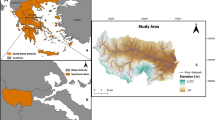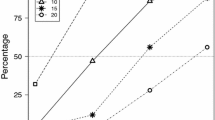Abstract
Ranking problems arise from the knowledge of several binary relations defined on a set of alternatives, which we intend to rank. In a previous work, the authors introduced a tool to confirm the solutions of multi-attribute ranking problems as linear extensions of a weighted sum of preference relations. An extension of this technique allows the recognition of critical preference pairs of alternatives, which are often caused by inconsistencies. Herein, a confirmation procedure is introduced and applied to confirm the results obtained by a multi-attribute decision methodology on a tender for the supply of buses to the Porto Public Transport Operator.
Similar content being viewed by others
References
Arrow, K.J. (1963). Social Choice and Individual Values, 2nd edn. New York: Wiley.
Cardoso, D.M. and J.F. Sousa. (2003). “Numerical Tools for Multi-Attribute Ranking Problems”. NETWORKS 41(4), 229–234.
Dyer, J., P. Fishburn, R. Steuer, J. Wallenius, and S. Zionts. (1992). “MCDM/MAUT: The next ten years.” Management Science 38(5), 645–654.
Larichev, O.I. and H.M. Moshkovich. (1995). “ZAPRO-LM- A Method and System for Ordering Multiattribute Alternatives.” European Journal of Operational Research 82, 503–521.
Lootsma, F.A. (1992). The REMBRANDT system for multi-criteria decision analysis via pairwise comparisons or direct rating, Technical Report 92-05, Faculty of Technical Mathematics and Informatics, Delft University of Technology, Delft.
Olson, D.L. (2001). “Comparison of Three Multicriteria Methods to Predict Known Outcomes.” European Journal of Operational Research 130, 576–587.
Olson, D.L., G. Fliedner, and K. Currie. (1995). “Comparison of REMBRANDT System with Analytic Hierarchy Process.” European Journal of Operational Research 82, 522–539.
Roy, B. (1968). “Classement et choix en présence the points de vue multiples (la méthode ELECTRE).” Revue informatique et recherche opérationnelle, 2e année 8, 57–75.
Saaty, T.L. (1980). The Analytic Hierarchy Process, New York: McGraw-Hill.
Saaty, T.L. (1992). “Highlights and Critical Points in the Theory and Application of the Analytic Hierarchy Process.” European Journal of Operational Research 74, 426–447.
Triantaphyllou, E. (2001). Multi-Criteria Decision Making Methods: A Comparative Study, Dordrecht: Kluwer Academic Publishers.
Van Huylenbroeck, G. (1995). “The Conflict Analysis Method: Bridging the Gap Between ELECTRE, PROMETHE and ORESTE.” European Journal of Operational Research 82, 490–502.
Zanakis, S.H., A. Solomon, N. Wishart, and S. Dublish, (1998). “Multi-Attribute Decision Making: A Simulation Comparison of Select Methods.” European Journal of Operational Research 107, 507–529.
Author information
Authors and Affiliations
Corresponding author
Rights and permissions
About this article
Cite this article
Cardoso, D.M., de Sousa, J.F. A Multi-Attribute Ranking Solutions Confirmation Procedure. Ann Oper Res 138, 127–141 (2005). https://doi.org/10.1007/s10479-005-2449-y
Issue Date:
DOI: https://doi.org/10.1007/s10479-005-2449-y




